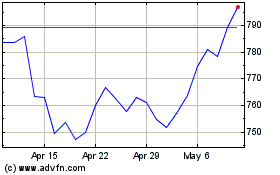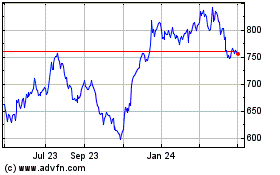By Dawn Lim
A broad set of bond exchange-traded funds are trading out of
sync with their underlying assets, testing investors' faith in a
fast-growing part of the investment world.
Bond ETFs of BlackRock Inc., Vanguard Group and others traded at
historic discounts to the net asset value of their underlying bonds
in recent days. The iShares iBoxx USD Investment Grade Corporate
Bond ETF closed down at a discount of over 5% late last week, a
record since 2008. The $28 billion bond fund, with the ticker LQD,
typically trades within a fraction of a percentage point of the
bonds it is designed to track. It closed at a discount of over 1.5%
every day of the past week.
The discrepancies expose the most dramatic mismatch in years
between the liquidity promised by many ETFs and their underlying
bonds. Liquidity is the ease at which investors can cash out of
assets without sacrificing gains. While ETFs trade like stocks on
exchanges, the spreading coronavirus pandemic has snarled bond
trading and made securities from junk bonds to Treasurys harder to
price.
The abnormal gap is reigniting a debate about the resilience of
the ETFs if there is a prolonged rout. Investors pulled some $20
billion in net money from U.S. bond ETFs in the first few days of
the past week.
"Bond ETFs are promising perfect liquidity in markets that are
over-the- counter and have ad hoc, not instantaneous, liquidity,"
said Sonal Desai, chief investment officer of the fixed-income
group at Franklin Templeton Investments. "They now face a fairly
critical test."
The invention of the ETF allowed millions of investors to trade
entire markets almost instantaneously. Bond ETFs, which surpassed
$1 trillion in assets last year, are used by everyone from the
smallest day traders to the biggest sovereign-wealth funds.
The Vanguard Total Bond Market ETF, with the ticker BND, is one
of the world's largest such funds, with more than $50 billion in
assets. It traded at its biggest ever discount to net asset value
-- 6.2% -- earlier this month. It pared back the discount but still
traded at a larger-than-average discount to net asset value in the
past week.
Bond ETFs have always been susceptible to moving out of step
with their underlying investments because bonds trade more
infrequently, making it difficult for bond pricing services to
calculate their latest values.
Some say the liquidity mismatch highlights the fragility of bond
funds and raises questions about whether investors are getting a
fair price. Others say the ability of ETFs to house less-liquid
securities within a tradable wrapper attests to their importance
when news moves faster than trading in other markets can keep
up.
"You're getting a lot of information -- real-time information --
being transmitted by the ETF about conditions in the bond markets,"
said Samara Cohen, BlackRock's co-head of iShares markets and
investments. "Markets and bonds aren't trading fast enough to
validate or invalidate the information."
The Securities and Exchange Commission has regular check-in
conversations with asset managers to assess the quality of the
trading ecosystem around ETFs. In recent weeks, the agency's
officials have been asking if the mechanisms that allow ETFs to
trade in line with their underlying asset values are functioning as
they should, said people familiar with the matter.
The majority of ETF trading involves existing ETF shares
changing hands on exchanges. But behind the scenes, an army of Wall
Street traders carries out a different kind of trade just as
critical to the orderly functioning of the $6 trillion ETF
industry.
Each day, bank intermediaries and other middlemen buy baskets of
instruments to exchange for shares of ETFs, or vice versa, to
profit from price differences. Those trades keep ETF prices in
check with their underlying investments and essentially prevent
those funds from turning into closed-end funds.
It is more challenging doing that trade in choppy markets.
Traders and investors say bank credit desks are losing
confidence over how to price bonds and wrestling with how to price
the toll of a pandemic with no precedent in modern history. As
investors have scrambled to sell assets and unwind trades,
correlations between financial instruments have broken down and
liquidity has vaporized in parts of the bond market once seen as a
haven.
When the BlackRock ETF with the LQD ticker fell to steep
discounts to its underlying assets over the past month, BlackRock's
Ms. Cohen got on call after call with various Wall Street
intermediaries to rule out failures in the ETF. Wall Street traders
told BlackRock that the ETF was tradable. The issue was that many
of the underlying bonds weren't. That is how the fund was out of
sync with the net asset value of its investments. Less than half of
the bonds in that investment-grade corporate bond fund typically
trade in a day.
"That spread is an indication of the increased difficulty of
executing what should be a risk-free arbitrage," said Ken Monahan,
who focuses on market structure and technology at research firm
Greenwich Associates.
"The ETF complex is by no means broken," he added.
ETF traders say as long as there is a preponderance of buyers
and sellers on exchanges, the market is fair.
In March, bond ETF trading made up a higher average daily share
of equities trading compared with the average day last year,
according to a Wall Street Journal analysis of the New York Stock
Exchange data on U.S. exchange trading volumes.
At Vanguard, the average daily dollar volume of fixed-income
ETFs trading in the first four days of last week was five times
higher than the previous year's average.
"This is why ETFs are thought to be the vehicle for price
discovery," said Rich Powers, Vanguard's head of ETF product
management. "It's not to say it's the perfect price. There is no
perfect price in the bond market."
In an acknowledgment that bond market liquidity is harder to
find, Vanguard and BlackRock made it more expensive last week for
some Wall Street intermediaries to get redemptions from certain
bond ETFs in cash.
Write to Dawn Lim at dawn.lim@wsj.com
(END) Dow Jones Newswires
March 23, 2020 08:14 ET (12:14 GMT)
Copyright (c) 2020 Dow Jones & Company, Inc.
BlackRock (NYSE:BLK)
Historical Stock Chart
From Mar 2024 to Apr 2024

BlackRock (NYSE:BLK)
Historical Stock Chart
From Apr 2023 to Apr 2024
